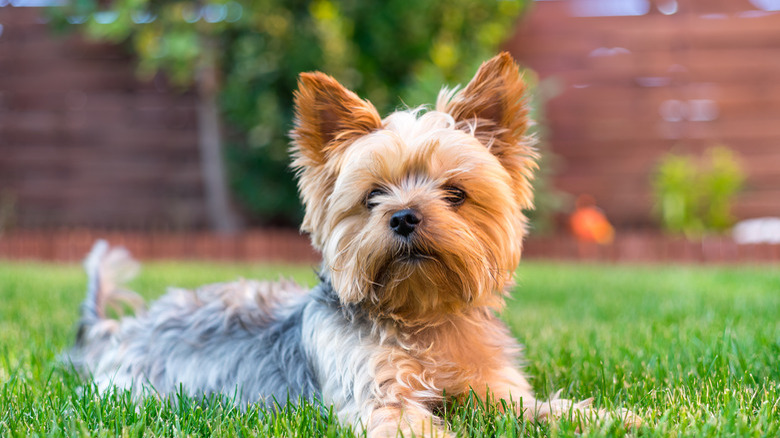The Difference Between A Parti Yorkie & A Regular Yorkie
Yorkshire terriers are famous for their long, silky hair, tiny bodies, and big attitudes. They make great companions and are notably loyal and brave, particularly for a little dog. While most people are familiar with the "traditional" Yorkie coloring which is made up of two of either black, tan, and blue, these are far from the only colors the breed can come in. A parti Yorkie simply has different coloring than a "regular" one.
About the parti Yorkie
So what exactly is a "parti" Yorkshire terrier and how does it differ from a regular Yorkie? Well, the same way a chocolate or black lab is still a Labrador retriever, Yorkie Life explains that the parti Yorkie is just a different color of the same breed. Traditional Yorkies, which were once the only color variation accepted by the AKC, are black and tan, black and blue (a silvery color), or blue and tan, but parti coloration comes in any combination of these colors as well as white or chocolate. While the most common coloration of parti dogs is black, white, and tan, they can have any number of colors, or even be a solid shade, which is why you may sometimes see an all-chocolate Yorkie or an all-blonde Yorkie.
The gene for parti coloring is recessive, which means that both parents have to carry the parti genes in order to have a parti pup in the litter. That being said, many traditional-looking yorkis carry the parti gene even if they don't display any of the coloration and two of these dogs can still produce a litter with parti pups in it. Similarly, if two parti Yorkies breed, the litter could have traditional-looking Yorkies in it with no parti coloring. If either of the parents does not carry a parti gene, the resulting litter will not have any parti pups, although the puppies may carry the gene and have parti puppies of their own one day.
History of parti Yorkies
Parti coloring has always been a part of the Yorkshire breed, but for a long part of the breed's history, these pups were considered low-quality and not real Yorkies. Historically, Elvis Yorkshire terrier notes that many Yorkshire terriers were bred with Maltese dogs to improve the length and quality of the breed's coat. Unfortunately, while they appeared in the breed's history since as far back as the 1800s, many breeders believed these oddly-colored Yorkies were a result of genes left over from the Maltese or other cross-breeding, meaning they weren't true purebreds. Some breeders would secretly give away these supposedly miscolored dogs, but some would even kill the dogs in a misguided attempt to protect the purity of the breeding line.
After one legitimate breeder refused to put down their parti pups in the 1980s, more and more breeders started following suit and finally acknowledged that purebred Yorkies could still produce parti pups. After researching these claims and conducting a DNA test, Yorkie Mag says that the AKC began to accept the parti coloration in 2000. Once the AKC changed its view, so did many breeders and suddenly parti Yorkies became popular and widely accepted.
While some modern breeders still believe parti Yorkies are not true Yorkies and that the breed shouldn't even have a gene for white coloring, most of the breed's fans have accepted the parti colorations with open arms and, in fact, there are some claims that the majority of AKC Yorkshire terrier registrations are now for parti-colored dogs.
